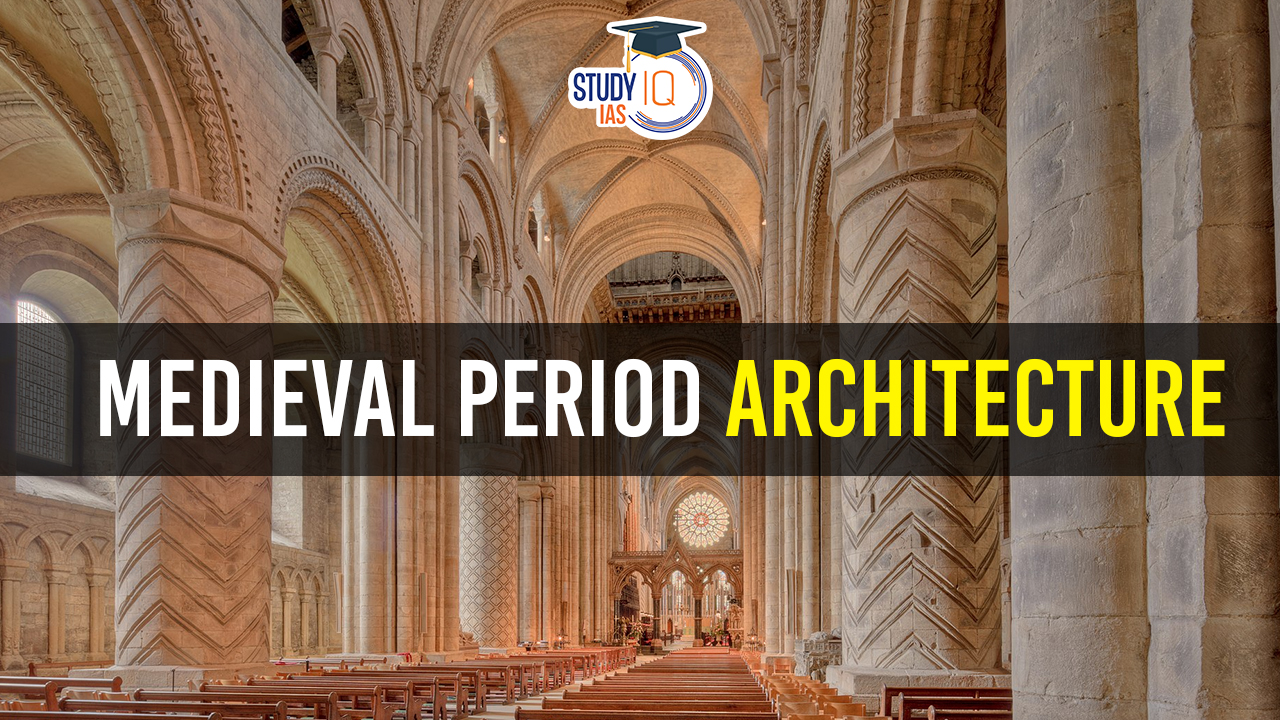Table of Contents
The Arab conquest of Sind in 712 A.D. initiated a sequence of events that ultimately led to the ascension of Islamic rulers in Delhi during the 11th century. Subsequently, the architectural landscape in Medieval India underwent a profound transformation. To align with the preferences of the new rulers, significant modifications emerged, incorporating elements such as calligraphy and intricate ornamentation through techniques like inlay work.
This period marked a distinctive shift in architectural styles, reflecting the influence of Islamic aesthetics and design principles in the construction of monumental structures.
We’re now on WhatsApp. Click to Join
Architecture in Medieval India
The Islamic rulers’ conquest of Delhi brought about substantial alterations in Medieval Indian architecture. Nevertheless, local architects preserved elements of indigenous architectural traditions amidst these changes. Consequently, the architectural landscape of the subsequent period witnessed a harmonious fusion of Persian and Indian styles. This synthesis is commonly recognized as Indo-Islamic architecture or Indo-Saracenic architecture, showcasing a unique blend of cultural influences in monumental constructions.
Early Medieval Period Architecture in India
The Early Medieval Period in India, spanning from the 6th to the 12th century, witnessed the construction of various architectural marvels influenced by diverse cultural, religious, and regional factors. Different dynasties and empires contributed to the rich architectural heritage of this period. Here are some key features and examples of Early Medieval architecture in India:
Chalukya Architecture
- The Chalukya dynasty, particularly the Badami Chalukyas, contributed to the construction of rock-cut caves and structural temples.
- Examples include the Badami Cave Temples in Karnataka and the Virupaksha Temple in Pattadakal.
Pallava Architecture
- The Pallavas, based in the southern region of India, built monolithic rock-cut temples and structural temples.
- The Shore Temple in Mamallapuram (Mahabalipuram), a UNESCO World Heritage Site, is an exemplary structural temple from this period.
Rashtrakuta Architecture
- The Rashtrakutas, who ruled in the Deccan region, left behind impressive examples of rock-cut cave temples.
- The Kailasa Temple at Ellora, dedicated to Lord Shiva, is a remarkable achievement in rock-cut architecture.
Gupta and Post-Gupta Architecture
- Although the Gupta Empire primarily falls into the earlier period, the architectural styles persisted into the Early Medieval Period.
- The Dashavatara Temple at Deogarh in Uttar Pradesh is an example of Gupta architecture.
Pratihara Architecture
- The Gurjara-Pratiharas, centered in present-day Rajasthan, contributed to the construction of structural temples.
- The Bateshwar group of temples and the Ambika Mata Temple in Jagat are notable examples.
Rajput Architecture
- Various Rajput dynasties constructed forts, palaces, and temples during this period.
- The Chittorgarh Fort in Rajasthan is an extensive fortification showcasing Rajput military architecture.
Buddhist Monuments
- Buddhist architecture continued to flourish during this period.
- The Ajanta and Ellora Caves in Maharashtra feature rock-cut caves with intricate sculptures and paintings.
Islamic Architecture
- The early Islamic rulers, such as the Delhi Sultanate, introduced elements of Islamic architecture.
- The Qutub Minar complex in Delhi, initiated by Qutub-ud-din Aibak, is a notable example.
Dravidian Temple Architecture
- In the southern regions, Dravidian temple architecture evolved with elaborate structures and towering gopurams (entrance towers).
- The Brihadeshwara Temple in Thanjavur, built by the Chola dynasty, is an iconic example.
Nagara Architecture
- In the northern regions, Nagara style temples with distinctive shikharas (towers) continued to be constructed.
- The Sas-Bahu Temples in Gwalior showcase Nagara architecture.
These examples represent the diversity and richness of Early Medieval architecture in India, where different regions and dynasties contributed to the development of unique styles and structures. The architectural achievements of this period laid the foundation for later medieval and subsequent architectural traditions in the subcontinent.
Islamic Architecture in India
Islamic architecture from the 12th to the 16th century encompasses a period of significant cultural, artistic, and architectural achievements within the Islamic world. This era witnessed the construction of remarkable structures, blending influences from various regions and reflecting the diversity of the Islamic civilization. Key features of Islamic architecture during this period include the development of new building techniques, the extensive use of geometric and floral ornamentation, and the integration of Islamic principles into architectural design.
Seljuk Architecture (12th Century)
- Influences: The Seljuk Turks, who established an empire in the Middle East, Central Asia, and Anatolia, were influenced by both Byzantine and Persian architectural traditions.
- Notable Examples:
- The Great Mosque of Isfahan in Iran: A masterpiece of Seljuk architecture, featuring a vast courtyard and an impressive dome.
- The Alaeddin Mosque in Konya, Turkey: Exhibits Seljuk elements with its unique wooden pulpit.
Mamluk Architecture (13th to 16th Century)
- Influences: The Mamluks, who ruled in Egypt and Syria, continued and further developed the architectural styles of their predecessors.
- Notable Examples:
- The Mosque of Sultan Hassan in Cairo, Egypt: Known for its massive size and intricate decorations.
- The Madrasa-Mausoleum of Sultan Qalawun in Cairo: Combines religious and funerary functions with an elegant design.
Ilkhanid and Timurid Architecture (13th to 15th Century)
- Influences: Ilkhanids in Persia and Timurids in Central Asia and India continued the Persian architectural tradition with additional influences from Mongol and Turkic cultures.
- Notable Examples:
- The Blue Mosque in Tabriz, Iran: Known for its blue tiles and impressive proportions.
- The Gur-e-Amir Mausoleum in Samarkand, Uzbekistan: Timurid masterpiece, later influencing the design of the Taj Mahal.
Moorish Architecture in Spain (12th to 16th Century)
- Influences: The Moors, who ruled parts of Spain, blended Islamic and local influences, leaving a lasting impact on Spanish architecture.
- Notable Examples:
- The Alhambra in Granada: A palace and fortress complex known for its intricate stucco work, tile mosaics, and gardens.
- The Great Mosque of Cordoba: Transformed into a cathedral after the Reconquista, it reflects the Umayyad style with horseshoe arches and ornate decoration.
Ottoman Architecture (14th to 16th Century)
- Influences: The Ottoman Empire incorporated elements from Byzantine, Persian, and Seljuk traditions into its own distinctive style.
- Notable Examples:
- The Topkapi Palace in Istanbul, Turkey: A palace complex showcasing Ottoman architecture and design.
- The Süleymaniye Mosque in Istanbul: Commissioned by Suleiman the Magnificent, it is one of the grandest Ottoman mosques.
Indo-Islamic Architecture (14th to 16th Century)
- Influences: In the Indian subcontinent, the Delhi Sultanate and later the Mughal Empire blended Islamic and indigenous architectural elements.
- Notable Examples:
- The Qutub Minar and the Quwwat-ul-Islam Mosque in Delhi: Early examples of Indo-Islamic architecture.
- The Humayun’s Tomb in Delhi: A precursor to the Taj Mahal, combining Persian and Indian architectural styles.
Islamic architecture during this period exemplifies the cultural synthesis, technical innovation, and aesthetic sophistication of the Islamic world. The construction of mosques, madrasas, palaces, and mausoleums reflects the multifaceted nature of Islamic civilization and its enduring impact on global architectural history.
Indo-Islamic Architecture in Regional Kingdoms
Indo-Islamic architecture in regional kingdoms refers to the unique architectural styles that emerged in different parts of the Indian subcontinent under the influence of Islamic rulers during the medieval period. These regional kingdoms developed their distinctive architectural traditions, blending Islamic elements with local building techniques and artistic styles. Here’s a detailed overview of Indo-Islamic architecture in some prominent regional kingdoms:
Gujarat Sultanate (14th to 15th Century)
- Influences:
- Blend of Persian, Central Asian, and indigenous Gujarati styles.
- Gujarati craftsmen integrated their artistic traditions with Islamic elements.
- Notable Examples:
- Jama Masjid in Ahmedabad: Features intricate stone carving and a large central dome.
- Sarkhej Roza: A complex including a mosque, tombs, and a tank, showcasing Indo-Saracenic architecture.
Bengal Sultanate (14th to 16th Century)
- Influences:
- Fusion of Persian, Afghan, and Bengali architectural styles.
- Extensive use of terracotta ornamentation.
- Notable Examples:
- Adina Mosque in Pandua: Known for its grand size, large prayer hall, and ornate terracotta decorations.
- Sixty Dome Mosque (Shaṭ Gombuj Moshjid) in Bagerhat: A UNESCO World Heritage Site, featuring 60 small domes.
Deccan Sultanates (14th to 17th Century)
- Influences:
- Synthesis of Persian, Central Asian, and local styles.
- Strong emphasis on military architecture.
- Notable Examples:
- Gol Gumbaz in Bijapur: A massive mausoleum with the second-largest dome in the world.
- Charminar in Hyderabad: An iconic monument with Indo-Islamic and Persian influences.
Malwa Sultanate (15th Century)
- Influences:
- Blend of Afghan and indigenous Malwa architectural styles.
- Use of local materials such as red sandstone.
- Notable Examples:
- Ashrafi Mahal in Mandu: An imposing palace complex featuring intricate geometric patterns and calligraphy.
- Jama Masjid in Mandu: A large mosque with beautiful decorative elements.
Jaunpur Sultanate (15th Century)
- Influences:
- Combination of Central Asian, Persian, and Indian architectural elements.
- Use of innovative construction techniques.
- Notable Examples:
- Atala Masjid: Known for its unique blend of Hindu and Islamic architectural styles.
- Jama Masjid: Exhibits a distinctive architectural style with high domes and minarets.
Ahom Kingdom in Assam (17th Century)
- Influences:
- Fusion of Islamic and local Ahom architectural traditions.
- Use of distinctive features like inverted lotus finials.
- Notable Examples:
- Barpeta Mosque: Features a blend of Ahom and Islamic architectural styles.
- Rang Ghar: While not Islamic, it reflects a synthesis of Ahom and Mughal architectural elements.
Vijayanagara Empire (14th to 16th Century)
- Influences:
- Fusion of Islamic, Dravidian, and Hoysala architectural styles.
- Development of a unique regional style known as the “Deccan style.”
- Notable Examples:
- Lotus Mahal in Hampi: A blend of Islamic and Vijayanagara architectural features.
- Jama Masjid in Hampi: Reflects the fusion of Indo-Islamic and Vijayanagara styles.
In each of these regional kingdoms, Indo-Islamic architecture took on unique characteristics, reflecting the cultural diversity and artistic ingenuity of the subcontinent. The synthesis of Islamic and local influences resulted in the creation of distinctive structures that contribute to the rich architectural tapestry of India.
Indo-Islamic Forts and Palaces
Indo-Islamic forts and palaces represent a fascinating blend of Islamic architectural principles and indigenous building traditions. These structures, built during the medieval period in various regions of the Indian subcontinent, served both defensive and residential purposes. They exhibit a synthesis of Islamic features such as arches, domes, and minarets with local materials and design elements. Here’s a detailed exploration of some notable Indo-Islamic forts and palaces:
Red Fort (Lal Qila), Delhi
- Period: Built during the Mughal era in the mid-17th century.
- Architectural Features:
- Impressive red sandstone walls and intricate white marble decorations.
- A combination of Persian, Timurid, and Indian styles.
- Diwan-i-Am (Hall of Public Audience) and Diwan-i-Khas (Hall of Private Audience) with iconic white marble pillars.
- Significance: Served as the main residence of Mughal emperors and a symbol of their power.
Agra Fort, Agra
- Period: Built by Akbar in the mid-16th century and later modified by subsequent Mughal rulers.
- Architectural Features:
- Red sandstone fortress with monumental gates.
- Diwan-i-Am and Diwan-i-Khas similar to those in the Red Fort.
- Jahangiri Mahal and Khas Mahal with intricate stone inlay work.
- Significance: A UNESCO World Heritage Site, the fort served as the main residence of the Mughal emperors until the completion of the Taj Mahal.
Golconda Fort, Hyderabad
- Period: Originally built in the 13th century and expanded by the Qutb Shahi dynasty in the 16th century.
- Architectural Features:
- Massive fort complex with strong military architecture.
- Ingenious acoustic design allowing communication across the fort.
- Gardens, palaces, and temples within the complex.
- Significance: An important military stronghold and later served as the capital of the Qutb Shahi dynasty.
Chittorgarh Fort, Rajasthan
- Period: Originally constructed in the 7th century and expanded by the Rajputs in the 14th and 15th centuries.
- Architectural Features:
- Impressive fortifications, including massive walls and gates.
- Vijay Stambha (Victory Tower) with intricate carvings.
- Rana Kumbha Palace with Mughal and Rajput architectural elements.
- Significance: One of the largest forts in India, symbolizing Rajput valor and resistance.
Bidar Fort, Karnataka
- Period: Built by the Bahmani Sultanate in the 15th century and later expanded by the Barid Shahi dynasty.
- Architectural Features:
- Persian and Turkish architectural influences.
- Rangin Mahal with exquisite tilework.
- Gagan Mahal, the audience hall for the royal court.
- Significance: A strong military fort with palatial structures, showcasing the cultural fusion of Deccan Sultanate architecture.
Junagarh Fort, Bikaner
- Period: Built in the 16th century by Raja Rai Singh, a general in the army of Emperor Akbar.
- Architectural Features:
- Massive fortifications with 37 bastions.
- Karan Mahal and Anup Mahal with intricate mirror work and paintings.
- Gaj Mandir, a room with stunning gold leaf paintings.
- Significance: An unconquered fort with a unique blend of Rajput and Mughal architectural styles.
Champaner-Pavagadh Archaeological Park, Gujarat
- Period: Built during the rule of Mahmud Begada in the late 15th and early 16th centuries.
- Architectural Features:
- Jami Masjid, an imposing mosque with a blend of Hindu and Islamic styles.
- Sahar ki Masjid, Nagina Masjid, and Kevada Masjid with unique architectural elements.
- Stepwells and fortifications on Pavagadh Hill.
- Significance: A UNESCO World Heritage Site, showcasing a unique blend of Islamic and regional architectural styles.
Indo-Islamic forts and palaces stand as testament to the cultural fusion and architectural brilliance that characterized the medieval period in the Indian subcontinent. These structures not only served practical purposes but also reflected the socio-cultural milieu of their time.
Indo-Islamic Tombs and Mausoleums
Indo-Islamic tombs and mausoleums are architectural marvels that emerged during the medieval period in the Indian subcontinent. These structures, often commissioned by rulers and nobility, reflect a synthesis of Islamic architectural elements with regional influences. Tombs and mausoleums served as final resting places for notable individuals and became important centers for artistic and cultural expression. Here is a detailed exploration of some notable Indo-Islamic tombs and mausoleums:
Taj Mahal, Agra
- Period: Built in the mid-17th century by Mughal Emperor Shah Jahan in memory of his wife Mumtaz Mahal.
- Architectural Features:
- Iconic white marble structure with intricate floral and geometric inlay work.
- Central dome surrounded by four minarets.
- Charbagh (four-part) garden layout.
- Significance: A UNESCO World Heritage Site, the Taj Mahal is one of the most recognized symbols of Mughal architecture and a testament to eternal love.
Humayun’s Tomb, Delhi
- Period: Constructed in the mid-16th century for the Mughal Emperor Humayun.
- Architectural Features:
- Garden tomb with a central octagonal chamber and a grand central dome.
- Persian-inspired chahar bagh garden layout.
- Red sandstone and white marble construction with intricate tile work.
- Significance: Considered a precursor to the Taj Mahal, it is a UNESCO World Heritage Site.
Qutub Minar Complex, Delhi
- Period: Built over several centuries, starting in the 12th century by Qutb-ud-din Aibak.
- Architectural Features:
- Qutub Minar, a tall minaret with intricate calligraphy and geometric patterns.
- Quwwat-ul-Islam Mosque, the earliest mosque built in Delhi.
- Ala-i-Darwaza and Alai Minar, additional structures within the complex.
- Significance: A UNESCO World Heritage Site, showcasing the evolution of Indo-Islamic architecture.
Bibi Ka Maqbara, Aurangabad
- Period: Built in the late 17th century by Mughal Emperor Aurangzeb in memory of his wife Dilras Banu Begum.
- Architectural Features:
- Resembles the Taj Mahal but on a smaller scale.
- Marble and limestone construction with intricate floral motifs.
- Charbagh garden layout.
- Significance: Often referred to as the “Poor Man’s Taj,” it reflects the declining architectural grandeur of the later Mughal period.
Gol Gumbaz, Bijapur
- Period: Built in the 17th century by the Adil Shahi dynasty for Sultan Muhammad Adil Shah.
- Architectural Features:
- Massive dome, the second-largest in the world, covering the central chamber.
- Whispering Gallery allowing sound to travel across the dome.
- Four towering minarets.
- Significance: A remarkable example of Deccani architecture, showcasing the grandeur of the Adil Shahi sultans.
Sher Shah Suri’s Tomb, Sasaram
- Period: Built in the 16th century in memory of Sher Shah Suri, the founder of the Suri dynasty.
- Architectural Features:
- Octagonal tomb with a large central dome.
- Red sandstone and marble construction.
- Mughal garden surrounding the tomb.
- Significance: Influential in the development of Mughal garden tomb architecture.
Ibrahim Rauza, Bijapur
- Period: Constructed in the 17th century by the Adil Shahi Sultan Ibrahim Adil Shah II.
- Architectural Features:
- Tomb and mosque complex with exquisite carvings.
- Central chamber with a large dome and surrounding minarets.
- Significance: Known for its intricate craftsmanship and detailed geometric patterns.
Indo-Islamic tombs and mausoleums not only serve as resting places for the departed but also stand as architectural and artistic masterpieces that reflect the cultural synthesis and sophistication of the medieval Indian subcontinent. Each structure is unique, bearing the influence of its time, regional context, and the vision of its patrons.
Medieval Period Architecture UPSC
The medieval period in India witnessed a transformative shift in architecture, spurred by the Arab conquest of Sind in 712 A.D. Islamic rule in Delhi from the 11th century onwards led to a fusion of Persian and Indian styles, known as Indo-Islamic architecture. The early medieval period (6th to 12th century) showcased architectural marvels from various dynasties, including the Chalukyas, Pallavas, Rashtrakutas, Guptas, Pratiharas, and Rajputs. The Islamic architecture (12th to 16th century) displayed cultural synthesis, with the Qutub Minar being an early example. Regional kingdoms, like Gujarat, Bengal, Deccan, Malwa, and Jaunpur, developed distinctive Indo-Islamic styles. Forts, palaces, and tombs, such as the Red Fort, Gol Gumbaz, and Taj Mahal, exemplified this unique synthesis, blending Islamic and indigenous influences.


 Chittorgarh Fort: Mining Ban within 10 k...
Chittorgarh Fort: Mining Ban within 10 k...
 PM Modi visits Wat Pho Temple in Bangkok
PM Modi visits Wat Pho Temple in Bangkok
 Mahabodhi Temple Complex at Bodh Gaya
Mahabodhi Temple Complex at Bodh Gaya





















